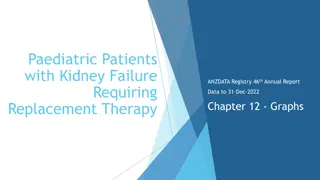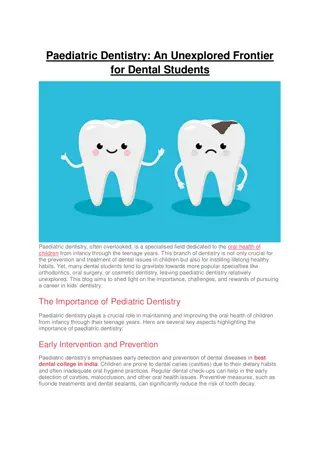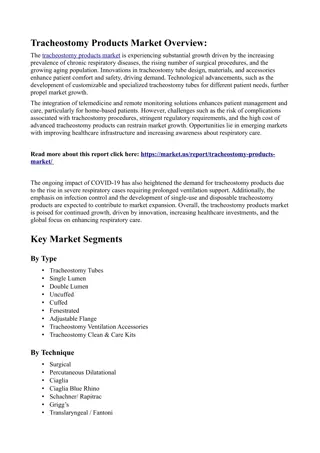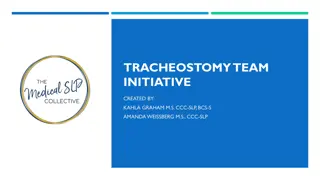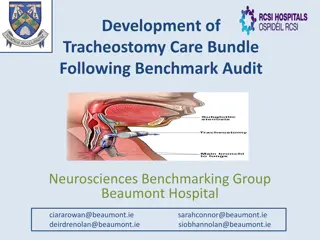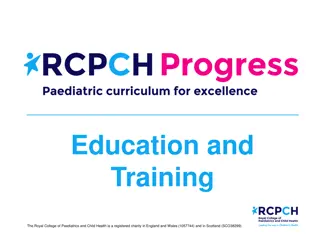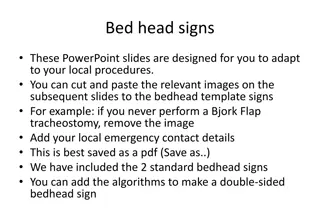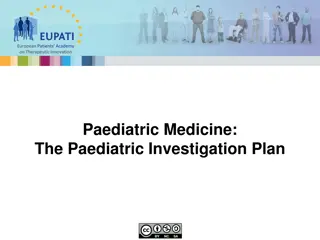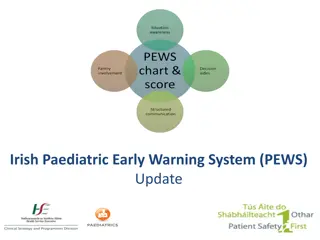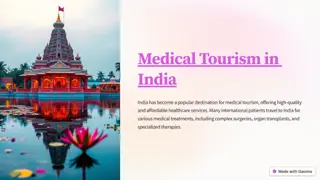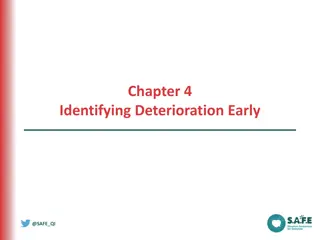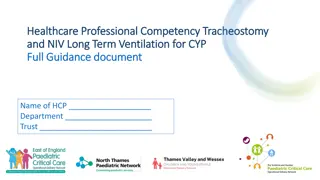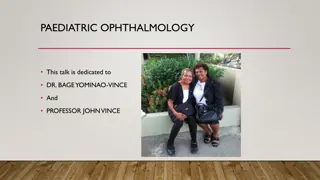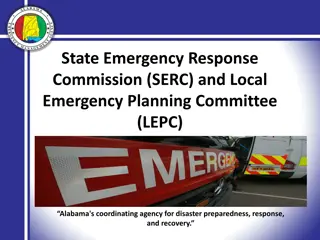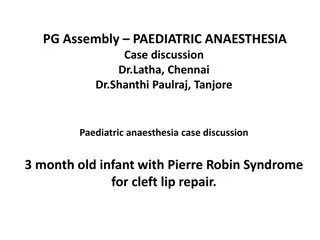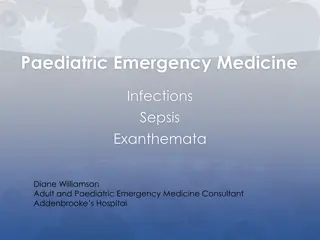Emergency Paediatric Tracheostomy Management Algorithm
Emergency Paediatric Tracheostomy Management Algorithm provides a structured approach for managing pediatric patients requiring tracheostomy in emergency situations. The algorithm outlines steps for assessing airway patency, performing suction, and changing the tracheostomy tube if necessary. It emphasizes safety measures, including oxygen administration and communication with the resuscitation team and ENT surgeon. The algorithm guides healthcare providers through interventions to ensure optimal airway management and patient safety.
Download Presentation

Please find below an Image/Link to download the presentation.
The content on the website is provided AS IS for your information and personal use only. It may not be sold, licensed, or shared on other websites without obtaining consent from the author. Download presentation by click this link. If you encounter any issues during the download, it is possible that the publisher has removed the file from their server.
E N D
Presentation Transcript
Indicate on this diagram any sutures in place Follow the Emergency Paediatric Tracheostomy Management Algorithm on reverse In an Emergency: Call 2222 and request the Resuscitation Team and ENT surgeon Document laryngoscopy grade and notes on upper airway management or patient specific resuscitation plans Due 1st tracheostomy change: ___ / ___ / ___ (by ENT ONLY) NEW TRACHEOSTOMY ______ FG Catheter to Depth ______ cm ______mm ID, ______ mm distal length This paediatric patient has a including cuff or inner tube Add tube specification Patient Label / Details UPPER AIRWAY ABNORMALITY: Yes / No Tracheostomy: Patient ID: Suction:
Emergency Paediatric Tracheostomy Management SAFETY - STIMULATE - SHOUT FOR HELP - OXYGEN SAFE: AIRWAY: OXYGEN: CAPNOGRAPHY: Exhaled carbon dioxide waveform may indicate a patent airway (advanced response) Check Safe area, Stimulate, and Shout for help Open child s airway: head tilt / chin lift / pillow or towel under shoulders may help Ensure high flow oxygen to the tracheostomy AND the face as soon as oxygen available SUCTION TO ASSESS TRACHEOSTOMY PATENCY Basic Response The tracheostomy tube is patent Perform tracheal suction Consider partial obstruction Remove attachments:humidifier (HME), speaking valve Change inner tube (if present) Inner tubes may need re-inserting to connect to breathing circuits Can you pass a SUCTION catheter? CONTINUE ASSESSMENT (ABCDE) Yes No EMERGENCY TRACHEOSTOMY TUBE CHANGE Deflate cuff (if present). Reassess patency after any tube change 1st change same size tube 2nd change one-half size smaller tube 3rd change - over suction catheter to guide IF UNSUCCESSFUL REMOVE THE TUBE IS THE PATIENT BREATHING? - Look, listen and feel at the mouth and tracheostomy/stoma No Yes CALL FOR HELP: 2222 in hospital, 999 in community Continue oxygen Stabilize Reassess Review 5 RESCUE BREATHS Patent Upper Airway use the nose/mouth Obstructed Upper Airway use the tracheostomy/stoma Plan for definitive airway if tube change failure NO SIGNS OF LIFE? START CPR 15 compressions : 2 rescue breaths Ensure help or resuscitation team called Advanced Response Secondary emergency oxygenation Primary emergency oxygenation ORAL intubation with endotracheal tube Uncut tube, advanced beyond stoma One half-size smaller than tracheostomy tube Difficult Airway Expert and Equipment* Standard ORALairway manoeuvres Cover the stoma (swabs / hand). Use: Bag-valve-face mask Oral or nasal airway adjuncts Supraglottic Airway (SGA) e.g. Laryngeal Mask Airway (LMA) Attempt intubation of STOMA 3.0 ID tracheostomy or endotracheal tube Difficult Airway Expert and Equipment* Tracheostomy STOMA ventilation Paediatric face-mask applied to stoma SGA applied to stoma *EQUIPMENT: Fibreoptic scope, bougie, airway exchange catheter, Airway trolley NTSP (Paediatric Working Group) www.tracheostomy.org.uk Review January 2024
Follow the Emergency Paediatric Tracheostomy Management Algorithm on reverse In an Emergency: Call 2222 and request the Resuscitation Team and ENT surgeon Document laryngoscopy grade and notes on upper airway management or patient specific resuscitation plans TRACHEOSTOMY ______ FG Catheter to Depth ______ cm ______mm ID, ______ mm distal length This paediatric patient has a including cuff or inner tube Add tube specification Patient Label / Details UPPER AIRWAY ABNORMALITY: Yes / No Tracheostomy: Patient ID: Suction:
Emergency Paediatric Tracheostomy Management SAFETY - STIMULATE - SHOUT FOR HELP - OXYGEN SAFE: AIRWAY: OXYGEN: CAPNOGRAPHY: Exhaled carbon dioxide waveform may indicate a patent airway (advanced response) Check Safe area, Stimulate, and Shout for help Open child s airway: head tilt / chin lift / pillow or towel under shoulders may help Ensure high flow oxygen to the tracheostomy AND the face as soon as oxygen available SUCTION TO ASSESS TRACHEOSTOMY PATENCY Basic Response The tracheostomy tube is patent Perform tracheal suction Consider partial obstruction Remove attachments:humidifier (HME), speaking valve Change inner tube (if present) Inner tubes may need re-inserting to connect to breathing circuits Can you pass a SUCTION catheter? CONTINUE ASSESSMENT (ABCDE) Yes No EMERGENCY TRACHEOSTOMY TUBE CHANGE Deflate cuff (if present). Reassess patency after any tube change 1st change same size tube 2nd change one-half size smaller tube 3rd change - over suction catheter to guide IF UNSUCCESSFUL REMOVE THE TUBE IS THE PATIENT BREATHING? - Look, listen and feel at the mouth and tracheostomy/stoma No Yes CALL FOR HELP: 2222 in hospital, 999 in community Continue oxygen Stabilize Reassess Review 5 RESCUE BREATHS Patent Upper Airway use the nose/mouth Obstructed Upper Airway use the tracheostomy/stoma Plan for definitive airway if tube change failure NO SIGNS OF LIFE? START CPR 15 compressions : 2 rescue breaths Ensure help or resuscitation team called Advanced Response Secondary emergency oxygenation Primary emergency oxygenation ORAL intubation with endotracheal tube Uncut tube, advanced beyond stoma One half-size smaller than tracheostomy tube Difficult Airway Expert and Equipment* Standard ORALairway manoeuvres Cover the stoma (swabs / hand). Use: Bag-valve-face mask Oral or nasal airway adjuncts Supraglottic Airway (SGA) e.g. Laryngeal Mask Airway (LMA) Attempt intubation of STOMA 3.0 ID tracheostomy or endotracheal tube Difficult Airway Expert and Equipment* Tracheostomy STOMA ventilation Paediatric face mask applied to stoma SGA applied to stoma *EQUIPMENT: Fibreoptic scope, bougie, airway exchange catheter, Airway trolley NTSP (Paediatric Working Group) www.tracheostomy.org.uk Review January 2024












